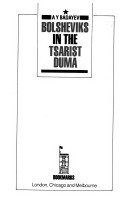‘Bolshevik Deputies in the Tsarist Duma’
BOOK REVIEW
 The centenary of the Russian Revolution has brought a burst of interest in one of the most profound and significant events of the 20th century. Major bourgeois organs like the New York Times, the BBC and National Public Radio characterize the Russian Revolution as an “extraordinary coup.” They dwell on its “totalitarian” nature and the way the German imperialists allowed Lenin to cross Germany in a sealed train in order to return to Russia.
The centenary of the Russian Revolution has brought a burst of interest in one of the most profound and significant events of the 20th century. Major bourgeois organs like the New York Times, the BBC and National Public Radio characterize the Russian Revolution as an “extraordinary coup.” They dwell on its “totalitarian” nature and the way the German imperialists allowed Lenin to cross Germany in a sealed train in order to return to Russia.
A little less than 90 years ago, Alexsei Egorovich Badayev published a book that supplies a sharp response to the bourgeois lies. Called “Bolshevik Deputies in the Tsarist Duma,” it is an engaging, detailed description of how Badayev and five comrades conducted the class struggle inside the fourth Duma, or assembly.
The Duma was a sop, a talking shop set up after the 1905 Revolution in Russia, to let various social forces vent. It was dominated by the Black Hundreds, a reactionary party representing the feudalistic landlords, clergy and government bureaucrats in autocratic Russia. The other major party was the Cadets, representing the liberal bourgeoisie, which was opposed to reactionary aspects of the tsarist government but didn’t really challenge it or support the workers.
Lenin and other Bolshevik leaders saw running candidates “as an opportunity for far-reaching agitation and propaganda and as one of the means of organizing the masses.” (Badayev, Chapter 1) Winning more seats and engaging in parliamentary maneuvers to make slight improvements were not on their agenda. Instead, gaining a podium as a way of speaking to all the workers in Russia was significant for the Bolsheviks, whose party was still illegal and couldn’t function openly.
Their platform, drawn up by Lenin, had three main points: a democratic republic, an eight-hour day and the confiscation of all landlords’ estates. This minimum program of the Bolsheviks implied getting rid of the tsar and giving the peasants land.
Six Bolshevik deputies were elected by a constituency restricted to workers. They took their seats in 1912 and held them until 1915, when they were arrested and exiled after Russia entered World War I.
Badayev, who was a metal worker and a Bolshevik when he was elected, wrote the book as an account of the struggles he and his comrades were engaged in. It explains how they followed their party’s lead in supporting workers in their struggles, using their Duma podium to state the Bolshevik position on the issues of the day.
The workers saw the Bolshevik deputies as theirs. If they had a problem, if there was a spontaneous strike, a funeral or a case of poisoning, they came to the deputies.
Badayev recounts that before the deputies had their own office, workers used to come to their apartments. Sometimes the line stretched out the door of his apartment and down the stairs.
One of the first major attacks of the tsarist army against workers was the Lena gold fields massacre in early April 1912, in which 500 workers were shot dead during a protest. Lena is in northeast Siberia, which was then even more remote than now.
Once the news of the massacre spread, the Bolshevik deputies organized massive political protest strikes in St. Petersburg and many other industrial centers.
At the beginning of the fourth Duma, the Bolsheviks were in a bloc with the Mensheviks — a party imbued with traditions similar to those of today’s social-democratic parties of western Europe.
After a series of problems working with the Mensheviks, the Bolsheviks decided to split and form their own caucus in the Duma.
But they didn’t just walk out. Badayev describes in detail how they held meetings and solicited comments, resolutions and contributions from unions in St. Petersburg and elsewhere in Russia. Lenin pointed out that of the donations given to political newspapers by workers’ organizations in Russia, four-fifths went to Pravda, the one associated with the Bolsheviks; the Menshevik paper got the rest.
A few months after Russia entered World War I, the tsarist secret police arrested the Bolshevik deputies and a few other leaders with whom they were meeting. After a swift trial, they were convicted and exiled — until the revolution of February 1917 led to their release.
In an article printed in April 1912, Lenin explained that “our Party goes into the Duma … in order to call the masses to the struggle from the Duma rostrum, to explain the teachings of socialism, to expose every government and liberal deception, to expose the monarchist prejudices of the backward sections of the people, and the class roots of the bourgeois parties — in other words, in order to prepare an army of class-conscious fighters for a new Russian revolution.” (Marxist Internet Archive, Lenin Collected Works, vol. 17, pp. 506-12)
That they did, and A.E. Badayev wrote a very interesting book on how they did it. Many libraries have it, and it is available online from the Marxist Internet Archive.

